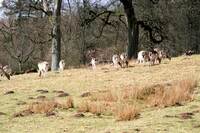- England
- Scotland
- France
- Holland
- Germany
- Italy
- Spain
- Portugal
- USA
- China
- Japan
- India
- Iran
- Advice
- Gardens
- England
- Scotland
- France
- Holland
- Germany
- Italy
- Spain
- Portugal
- USA
- China
- Japan
- India
- Iran
- Advice
- Garden Tours
Book: Landscape Planning and Environmental Impact Design: from EIA to EID
Chapter: Chapter 4 Public open space POS
Country areas of key importance to a nation should be given the protection of national park status. National parks in rural areas should be diverse, as should their urban counterparts. Places should be chosen because they contain something which is of great importance to the nation: - a scenic area - a historic area - an area of great species diversity - a natural process area - a recreation area True 'National Parks' are not discussed in this book, but they do illustrate some important principles, which apply to other aspects of park planning. The first National Parks, in America , were chosen for their scenic splendour and were wholly in public ownership. Their advocates hoped they would give America something to rival the historic wonders of Europe . A later generation of National Parks, in Europe , was created on land in private ownership. As with urban parks, there is every reason to use both principles. Another interesting point about Europe 's National Parks is that they have been designated for a variety of different purpopses: some for scenic splendour, some for the conservation of plants and animals, some because they are the locus of important ecological processes, some for recreation. Each of these could become a main objective for park planning in and near urban areas. The Lake District [Fig 4.17] was a remote part of England in 1810 but Wordsworth was concerned that 'the Lakes will fall almost entirely into the possession of gentry, either strangers or natives' and expressed the hope that 'the author will be joined by persons of pure taste throughout the whole island' in testifying that the Lake District should become 'a sort of national property, in which every man has a right and interest who has an eye to perceive and a heart to enjoy' (Wordsworth 1970 edn: 91). In the nineteenth century no public action was taken to protect the Lake District , but national parks were established in America . John Colter, returned after four years in the Rocky Mountains in 1810 with stories of high mountains, deep chasms, spouts of boiling water and terrific waterfalls in a place now known as 'Colter's Hell'. An organised party was sent in 1870 and recommended that the area should be protected. A park bill in 1872 established Yellowstone as the world's first national park (Runte 1979: 33). Since the land had never been settled and already belonged to the Federal Government there was no need to expropriate white-skinned landowners. It was a tract of 'wilderness' which became a park. By 1962 there were 1,200 national parks in the world. Britain had no large tracts of land in state ownership which were suited to becoming National Parks but the desire, first voiced by Wordsworth, to protect areas of outstanding landscape value, has been strong. A privately financed National Trust was founded in 1895 to preserve places of historic interest and natural beauty (Lees-Milne 1945). By 1970 it owned over 162,000 hectares of land ï¾ a comparatively small area which is equal to one fifth of Yellowstone National Park, or the total area occupied by Britain's road verges (Taber 1973: iii). In 1931 the Addison Committee reported in favour of a national parks policy for Britain and the National Parks and Access to the Countryside Act was passed in 1949. Designation as a national park did not change the ownership. It r ema ined private. The idea was to use financial aid and the 1947 Town and Country Planning Act to: ï¾ preserve natural beauty, ï¾ improve facilities for recreation, ï¾ protect natural and cultural features, ï¾ maintain the land in agricultural use, Despite numerous conflicts between the objectives, some lack of finance, and some lack of resolve from local and central government, there can be no doubt that designation as a National Park has furthered each of the above objectives. Financial subsidy and strict planning control are effective tools. When used in concert, they produce more interesting results than central government ownership-management.
